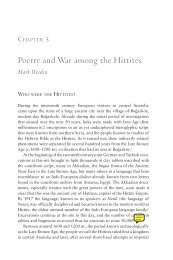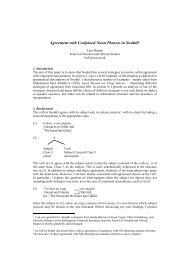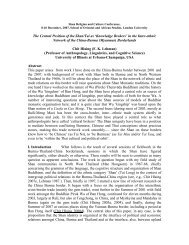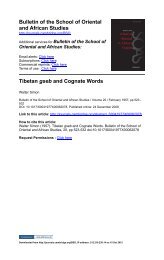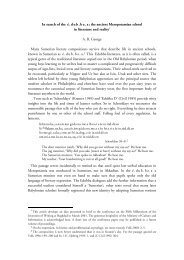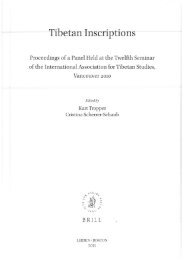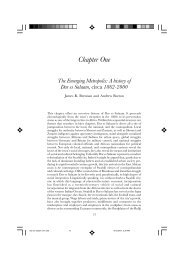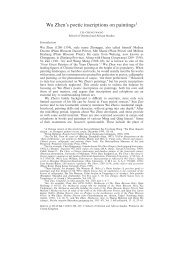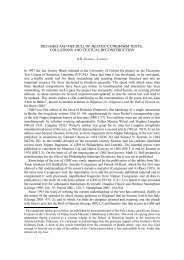Download (316Kb) - SOAS Research Online - The School of ...
Download (316Kb) - SOAS Research Online - The School of ...
Download (316Kb) - SOAS Research Online - The School of ...
You also want an ePaper? Increase the reach of your titles
YUMPU automatically turns print PDFs into web optimized ePapers that Google loves.
indo-iranian gar ‘to raise al<strong>of</strong>t’ 257<br />
auuaoiriˇsta-, it denotes the handling <strong>of</strong> a weapon in preparation for a physical<br />
attack.<br />
3. Conclusion<br />
This investigation shows that while the alleged Avestan evidence for gar ‘to<br />
raise (one’s hand or weapon preparatory to striking)’ has to be abandoned, forms<br />
<strong>of</strong> this root are attested in Vedic. <strong>The</strong>re remains, however, the semantic problem<br />
<strong>of</strong> how to reconcile the meaning <strong>of</strong> Vedic gar with that <strong>of</strong> Greek ÐÐÛ. <strong>The</strong> latter<br />
refers to ‘hitting by throwing’ using a weapon such as a spear, stone or arrow28 while, as rightly pointed out by Kellens, Noms-racines 151 n. 3, the cudgel is a<br />
weapon which is not thrown but held in the hand when striking an enemy. Yet in<br />
spite <strong>of</strong> their different use, Vedic gar and Greek ÐÐÛ are semantically close since<br />
both describe aspects <strong>of</strong> an action aimed at hitting an enemy with a weapon either<br />
held in or released from the hand. If the two verbs are etymologically related, the<br />
older Greek application would be that <strong>of</strong> hitting by throwing a weapon such as a<br />
spear or a stone, while the shooting <strong>of</strong> an arrow would be a later use. In order<br />
to achieve the maximum impact <strong>of</strong> the weapon thrown – at least as far as spear<br />
and stone are concerned – the aggressor has to raise his arm forcefully and aim<br />
precisely. This part <strong>of</strong> the action, which is essential and decisive for its success,<br />
is denoted in Vedic by gar, reinforced by the preverb apa ‘away’. <strong>The</strong> path <strong>of</strong><br />
the weapon from the aggressor’s hand to the enemy remains outside his control<br />
regardless <strong>of</strong> whether the weapon is hurled through the air or forcefully struck<br />
down on the victim while being held in the hand. In both forms <strong>of</strong> aggression, the<br />
success <strong>of</strong> the blow entirely depends on the preparatory stage <strong>of</strong> raising the arm<br />
and aiming precisely. Such stage is highlighted by the Vedic verb apa-gur, while<br />
the meaning <strong>of</strong> Greek ÐÐÛ focuses on the success <strong>of</strong> the action when the victim<br />
is hit.<br />
It may therefore be suggested that in IE the root *g w elh1 denoted the action<br />
<strong>of</strong> raising an arm with a weapon in one’s hand in order to hit an enemy. <strong>The</strong><br />
weapon could either be used to strike the victim while being retained in the<br />
aggressor’s hand or released and thrown through the air. In Greek, a semantic<br />
specialization took place in which the meaning was narrowed down to hitting an<br />
enemy with a weapon thrown at them. In Vedic the verb has become obsolete,<br />
presumably because <strong>of</strong> pressure from the homonymous roots gar ‘to welcome’ and<br />
gar ‘to swallow’. <strong>The</strong> verb in its original meaning survives only in two Rigvedic<br />
attestations and later as a legal technical term denoting, like its antecedent in the<br />
Rigveda, the forceful raising <strong>of</strong> one’s arm preparatory to striking with a weapon.<br />
28 Tichy 1979, 201 f.; Schaefer, Intensivum 119 with references.



